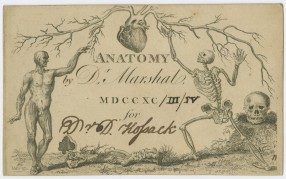Today’s guest post is written by Victoria Johnson, author of American Eden (Liveright, 2018). On October 9, Dr. Johnson will give a talk at the Academy on David Hosack (1769–1835), the visionary doctor who served as the attending physician at the Hamilton-Burr duel in 1804. Hosack founded or co-founded many medical institutions in New York City, among them nation’s first public botanical garden. The following is adapted from American Eden, which is on the longlist of ten works nominated for the National Book Award in Nonfiction for 2018.
David Hosack’s twin passions were medicine and nature. As a young medical student he risked his life to defend the controversial practice of corpse dissection because he knew it was the best chance doctors had to understand the diseases that killed Americans in droves every year. He studied with the great Philadelphia physician Benjamin Rush and went on to become a celebrated medical professor in his own right. He drew crowds of students who hung on his every word and even wrote down his jokes in their notebooks. He performed surgeries never before documented on American soil and advocated smallpox vaccination at a time when many people were terrified of the idea. He pioneered the use of the stethoscope in the United States shortly after its invention in France in 1816. He published one innovative medical study after another—on breast cancer, anthrax, tetanus, obstetrics, the care of surgical wounds, and dozens of other subjects. In the early twentieth century, a medical journal paid tribute to Hosack’s many contributions by noting that “there is perhaps no one person in the nineteenth century to whom New York medicine is more deeply or widely indebted than to this learned, faithful, generous, liberal man.”[i]

David Hosack’s admission card to Andrew Marshal’s anatomy course in London, 1793/94. Courtesy of Archives and Special Collections, Columbia University Health Sciences Library.
Yet although Hosack found surgery vital and exciting, he was certain that saving lives also depended on knowing the natural world outside the human body. As a young man, he studied medicine and botany in Great Britain, and he returned to the United States convinced that it was at their intersection that Americans would find the most promising new treatments for the diseases that regularly swept the country. Hosack talked and wrote constantly about the natural riches that blanketed the North American continent. The health of the young nation, he argued, would depend on the health of its citizens, and thus on the skill of its doctors in using plants to prevent and treat illness.
In 1801, Hosack bought twenty acres of Manhattan farmland and founded the first public botanical garden in the young nation. He collected thousands of specimens and used them to teach his Columbia students and to supervise some of the nation’s earliest pharmaceutical research.

David Hosack with his botanical garden in the distance. Engraving by Charles Heath, 1816, after oil paintings by Thomas Sully and John Trumbull, Collections of the National Library of Medicine.
Because of his garden, Hosack became one of the most famous Americans of his time. His medical research there cemented his reputation as the most innovative doctor in New York. When Alexander Hamilton and Aaron Burr needed an attending physician for their 1804 duel, they both chose David Hosack. Thomas Jefferson, Alexander von Humboldt, and Sir Joseph Banks sent Hosack plants and seeds for his garden and lavished praise on him. In 1816, he was elected to the Royal Society of London, an extraordinary honor for an American.
Today, though, few people know Hosack’s name, and his botanical garden grows skyscrapers year-round. It’s now Rockefeller Center.
Learn more about this luminary individual; join us for Losing Hamilton, Saving New York: Dr. David Hosack, Botany, and Medicine in the Early Republic at the Academy on Tuesday October 9th at 6pm.
References:
[i] Dr. David Hosack and His Botanical Garden,” Medical News 85, no. 11 (1904): 517-19 [no author], p. 517.
